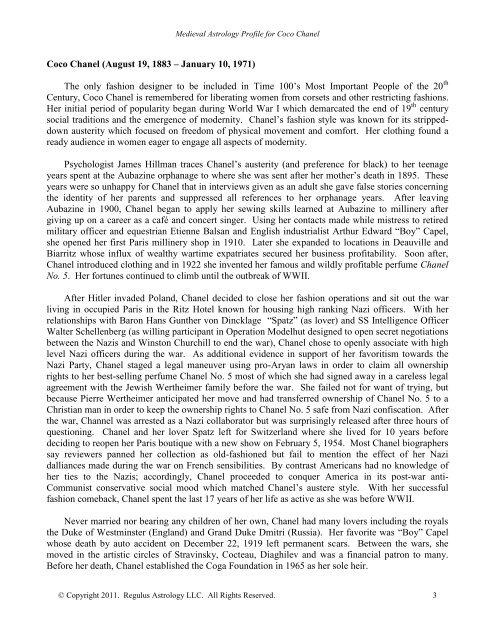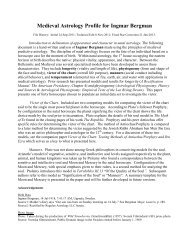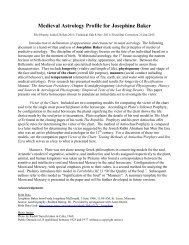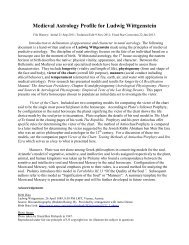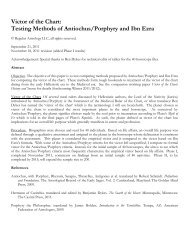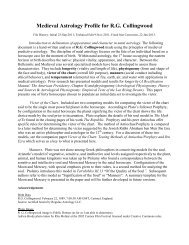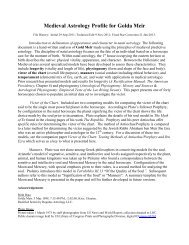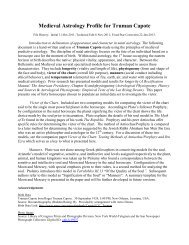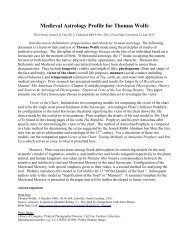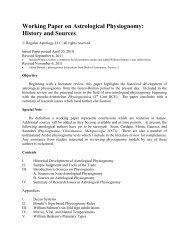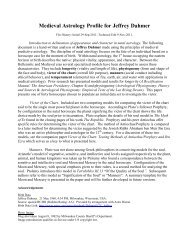Create successful ePaper yourself
Turn your PDF publications into a flip-book with our unique Google optimized e-Paper software.
Medieval <strong>Astrology</strong> Profile for <strong>Coco</strong> <strong>Chanel</strong><br />
<strong>Coco</strong> <strong>Chanel</strong> (August 19, 1883 – January 10, 1971)<br />
The only fashion designer to be included in Time 100’s Most Important People of the 20 th<br />
Century, <strong>Coco</strong> <strong>Chanel</strong> is remembered for liberating women from corsets and other restricting fashions.<br />
Her initial period of popularity began during World War I which demarcated the end of 19 th century<br />
social traditions and the emergence of modernity. <strong>Chanel</strong>’s fashion style was known for its strippeddown<br />
austerity which focused on freedom of physical movement and comfort. Her clothing found a<br />
ready audience in women eager to engage all aspects of modernity.<br />
Psychologist James Hillman traces <strong>Chanel</strong>’s austerity (and preference for black) to her teenage<br />
years spent at the Aubazine orphanage to where she was sent after her mother’s death in 1895. These<br />
years were so unhappy for <strong>Chanel</strong> that in interviews given as an adult she gave false stories concerning<br />
the identity of her parents and suppressed all references to her orphanage years. After leaving<br />
Aubazine in 1900, <strong>Chanel</strong> began to apply her sewing skills learned at Aubazine to millinery after<br />
giving up on a career as a café and concert singer. Using her contacts made while mistress to retired<br />
military officer and equestrian Etienne Balsan and English industrialist Arthur Edward “Boy” Capel,<br />
she opened her first Paris millinery shop in 1910. Later she expanded to locations in Deauville and<br />
Biarritz whose influx of wealthy wartime expatriates secured her business profitability. Soon after,<br />
<strong>Chanel</strong> introduced clothing and in 1922 she invented her famous and wildly profitable perfume <strong>Chanel</strong><br />
No. 5. Her fortunes continued to climb until the outbreak of WWII.<br />
After Hitler invaded Poland, <strong>Chanel</strong> decided to close her fashion operations and sit out the war<br />
living in occupied Paris in the Ritz Hotel known for housing high ranking Nazi officers. With her<br />
relationships with Baron Hans Gunther von Dincklage “Spatz” (as lover) and SS Intelligence Officer<br />
Walter Schellenberg (as willing participant in Operation Modelhut designed to open secret negotiations<br />
between the Nazis and Winston Churchill to end the war), <strong>Chanel</strong> chose to openly associate with high<br />
level Nazi officers during the war. As additional evidence in support of her favoritism towards the<br />
Nazi Party, <strong>Chanel</strong> staged a legal maneuver using pro-Aryan laws in order to claim all ownership<br />
rights to her best-selling perfume <strong>Chanel</strong> No. 5 most of which she had signed away in a careless legal<br />
agreement with the Jewish Wertheimer family before the war. She failed not for want of trying, but<br />
because Pierre Wertheimer anticipated her move and had transferred ownership of <strong>Chanel</strong> No. 5 to a<br />
Christian man in order to keep the ownership rights to <strong>Chanel</strong> No. 5 safe from Nazi confiscation. After<br />
the war, Channel was arrested as a Nazi collaborator but was surprisingly released after three hours of<br />
questioning. <strong>Chanel</strong> and her lover Spatz left for Switzerland where she lived for 10 years before<br />
deciding to reopen her Paris boutique with a new show on February 5, 1954. Most <strong>Chanel</strong> biographers<br />
say reviewers panned her collection as old-fashioned but fail to mention the effect of her Nazi<br />
dalliances made during the war on French sensibilities. By contrast Americans had no knowledge of<br />
her ties to the Nazis; accordingly, <strong>Chanel</strong> proceeded to conquer America in its post-war anti-<br />
Communist conservative social mood which matched <strong>Chanel</strong>’s austere style. With her successful<br />
fashion comeback, <strong>Chanel</strong> spent the last 17 years of her life as active as she was before WWII.<br />
Never married nor bearing any children of her own, <strong>Chanel</strong> had many lovers including the royals<br />
the Duke of Westminster (England) and Grand Duke Dmitri (Russia). Her favorite was “Boy” Capel<br />
whose death by auto accident on December 22, 1919 left permanent scars. Between the wars, she<br />
moved in the artistic circles of Stravinsky, Cocteau, Diaghilev and was a financial patron to many.<br />
Before her death, <strong>Chanel</strong> established the Coga Foundation in 1965 as her sole heir.<br />
© Copyright 2011. <strong>Regulus</strong> <strong>Astrology</strong> LLC. All Rights Reserved. 3


